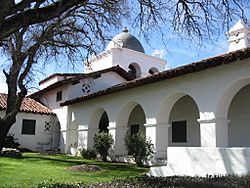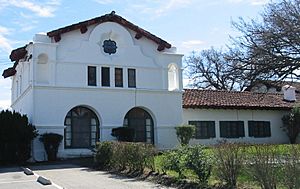The Hacienda (Milpitas Ranchhouse) facts for kids
Quick facts for kids |
|
|
Milpitas Ranchhouse
|
|

The northwest tower is a pointed Moorish dome
|
|
| Lua error in Module:Location_map at line 420: attempt to index field 'wikibase' (a nil value). | |
| Nearest city | Jolon, California |
|---|---|
| Built | 1930 |
| Architect | Julia Morgan |
| Architectural style | Mission Revival, Moorish Revival, Spanish Colonial Revival |
| NRHP reference No. | 77000310 |
| Added to NRHP | December 2, 1977 |
The Hacienda is a famous hotel in Monterey County, California. It was finished in 1930 for William Randolph Hearst. He used it to house his employees and guests. It was also a main spot for activities on his land.
The hotel building was designed by architect Julia Morgan. It replaced an older wooden building called the Milpitas Ranch House. That building burned down in the 1920s. The 1930 hotel has also been known by other names. These include Milpitas Hacienda and Hacienda Guest Lodge. It was added to the National Register of Historic Places on December 2, 1977.
The Hacienda has a restaurant, a lounge, and a cantina. It also has offices, meeting rooms, guest rooms, a swimming pool, and a tennis court. Hearst sold the building and land to the United States Army in 1940. It became a training center called Fort Hunter Liggett. Today, the Army owns the building. A company runs it as a public hotel inside the military base.
Contents
The Hacienda's Story
The rich valley around The Hacienda was first explored by Gaspar de Portolà in 1769. Based on his advice, Father Junípero Serra built Mission San Antonio de Padua there in 1771. The mission grew very well.
Mission San Antonio de Padua converted many Native Americans. It had 1,300 Salinan converts by 1805. In the 1830s, the mission's land was divided. It became at least ten land grants. One was Rancho Milpitas, or Little Corn Fields Ranch. These grants were given to soldiers and people who supported the Mexican government.
English-speaking settlers arrived in large numbers starting in 1849. This was because gold was found in California. Nearby Jolon became a gold mining town in 1860. It was built on an old Salinan village site. Jolon was also on El Camino Real, the old road connecting all the Spanish missions in California.
Hearst's Vision for the Ranch
At the start of the 1900s, gold mining had slowed down. William Randolph Hearst began buying land in the area. Over the next 20 years, he bought huge amounts of land. This included four of the ten Mexican land grants and most of Jolon.
Hearst hired Julia Morgan to build a new ranch headquarters. It was built on the site of the old Rancho Milpitas main house. This spot was on a small bluff, less than a mile from the old mission. Construction on the new building began in 1929. It was built in the Mission Revival style. They used poured concrete instead of adobe.
A smooth, domed north tower was built in the Moorish Revival style. It was above the main living areas. The first plans were for the building to house 20 employees. This was increased to 30 during construction. A planned southern wing for Hearst's private rooms was never finished. Building materials were brought from Santa Cruz by truck. The total cost to build was $200,000.

The building did not have electricity at first. Wires for one phone line came from Hearst Castle, about 30 miles (48 km) away. Wood stoves and fireplaces provided heat. Candles and lanterns gave light. A well near the San Antonio River fed a water tank uphill. This gave water pressure for modern plumbing.
People who lived at The Hacienda all year included the ranch manager, mechanics, and gardeners. There were also cooks and a ranch foreman. The foreman watched over cowboys tending cattle. Farmhands harvested wheat, barley, oats, and alfalfa.
Hearst's guests could drive in, fly in, or arrive by horseback. They could ride from San Simeon after a long day. Famous guests included Spencer Tracy, Dick Powell, and Will Rogers. Others were Clark Gable, Herbert Hoover, and Jean Harlow. Marion Davies, Hearst's partner, stayed in one of the four tower suites. Parties in the Californio style were held for guests. Mariachi bands played from the dining room balcony.
Even though hunting was popular in the area, Hearst did not allow it on his land. The California State Military Museum says The Hacienda was not built as a hunting lodge. However, some people have called it Hearst's hunting lodge.
The Army Takes Over

On December 12, 1940, Hearst sold 158,000 acres (64,000 ha) to the United States government. This included the old Milpitas Ranch. Other landowners sold another 108,950 acres (44,090 ha). This created a 266,950-acre (108,030 ha) training base for the War Department. The US Army used The Hacienda to house the base commander. It also served as a club for visiting officers.
In 1957, a soldier named Bill Runyan painted large murals inside The Hacienda. These murals showed the Spanish settling the area. Runyan started them as a soldier. He then stayed on as a carpenter to finish the work. Smaller decorative paintings in the hotel are from Hearst's time. The Army later touched them up or repainted them.
National Park Service Study
In November 1999, Congress approved a study of Fort Hunter Liggett. This was partly because a 1995 report said some buildings on the base were no longer needed by the Army. In 2004, the National Park Service (NPS) looked at the Julia Morgan-designed Milpitas Hacienda. This included the swimming pool, tennis court, and other buildings.
The NPS thought that adding The Hacienda to the national park system would be good. It would help visitors learn more about Julia Morgan and William Randolph Hearst. The NPS said The Hacienda showed how people expressed cultural values and built the American economy. They suggested two options: do nothing, or transfer The Hacienda to California State Parks. It would then become part of the Hearst San Simeon State Historical Monument.
However, the US Army told the NPS in May 2005 that they still needed The Hacienda. It was important for the Army's work. This change meant the NPS stopped its study of transferring the property. On September 19, 2006, the NPS sent its final report to Congress. It said that The Hacienda was suitable for a national park. But it was not possible at that time because the Army still needed the land and buildings. The NPS encouraged the Army to keep protecting the area's history and nature.
Images for kids
Today, the United States Army Reserve runs the base. A private company operates The Hacienda as a hotel. It is open to both the public and the military. Visitors must go through an Army checkpoint to access the base, the hotel, and the old Spanish mission.

